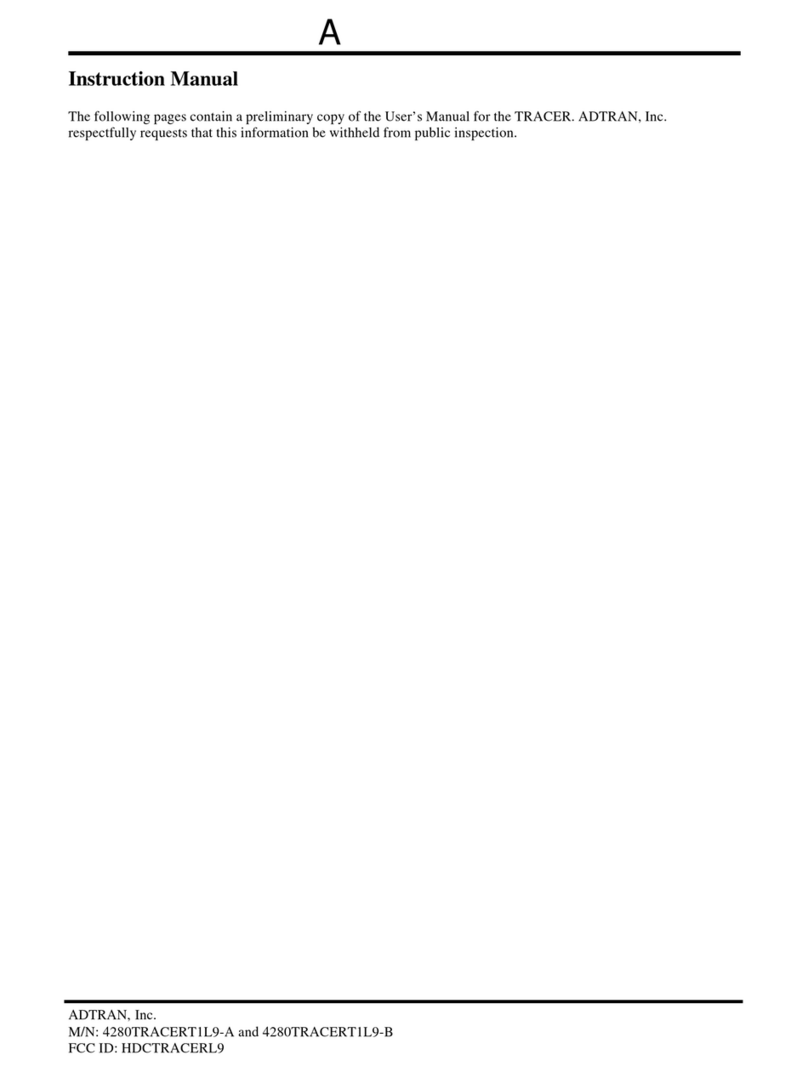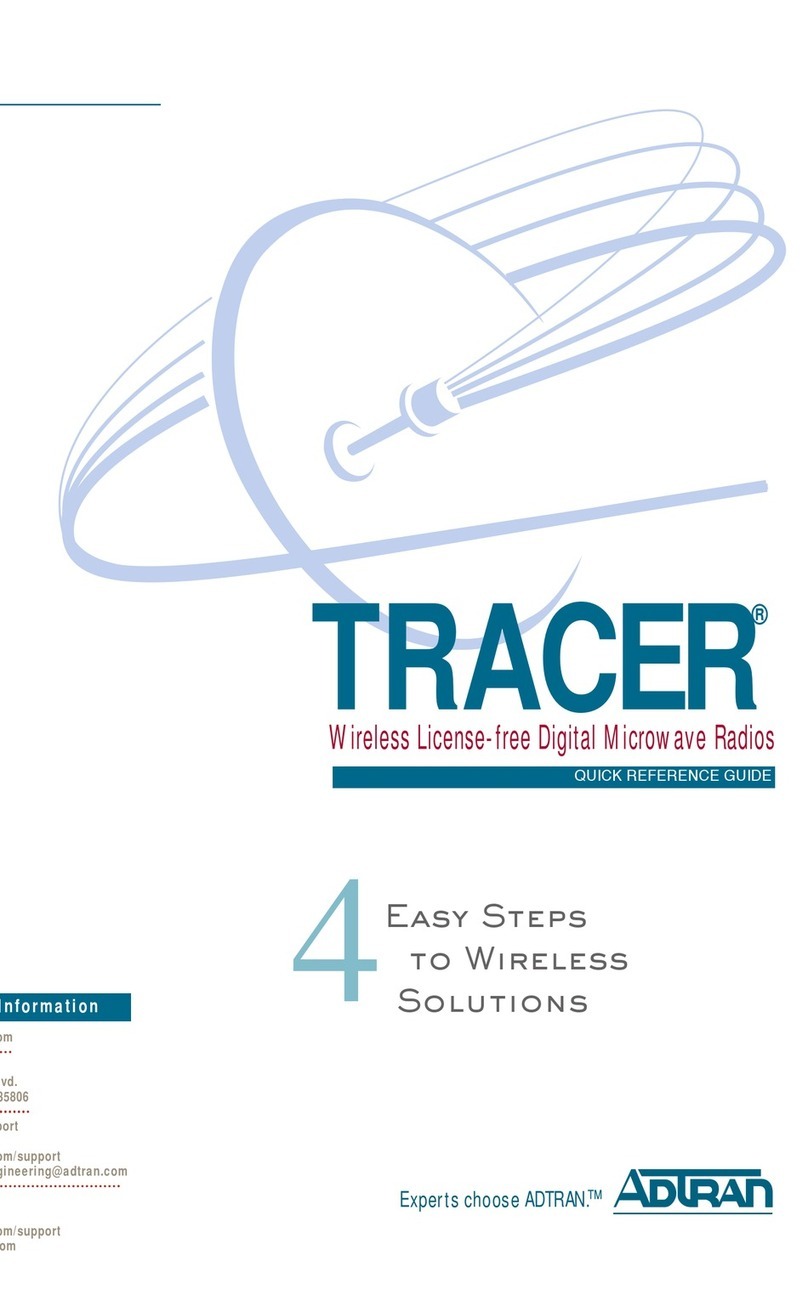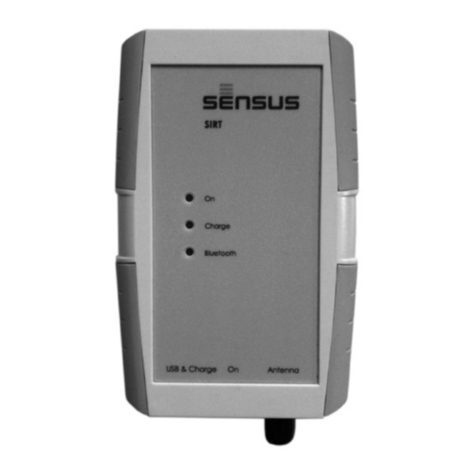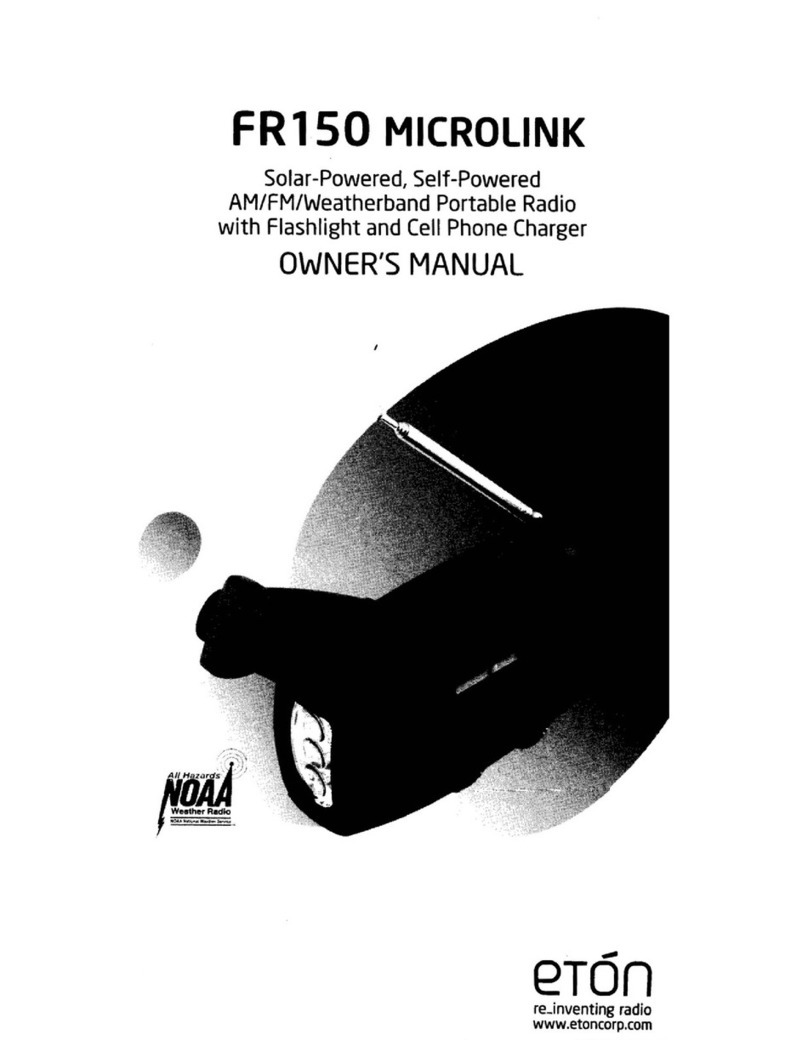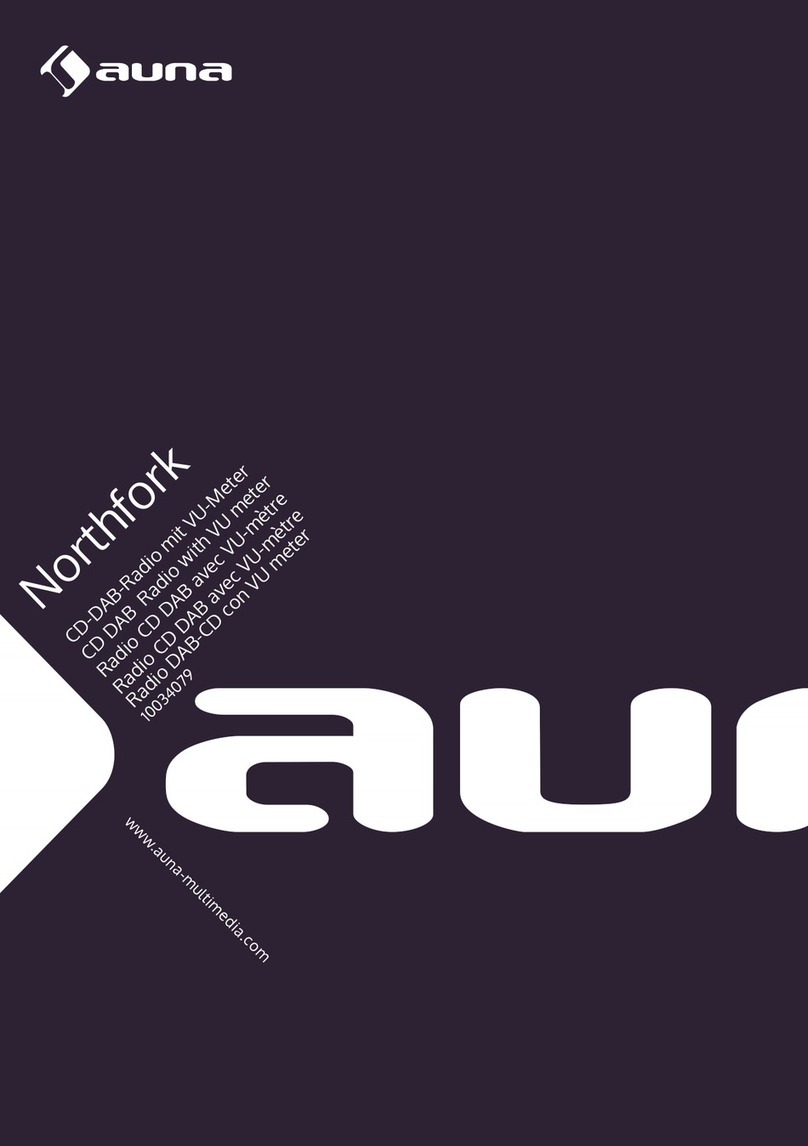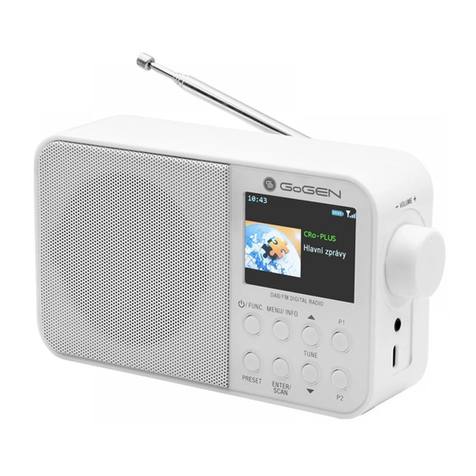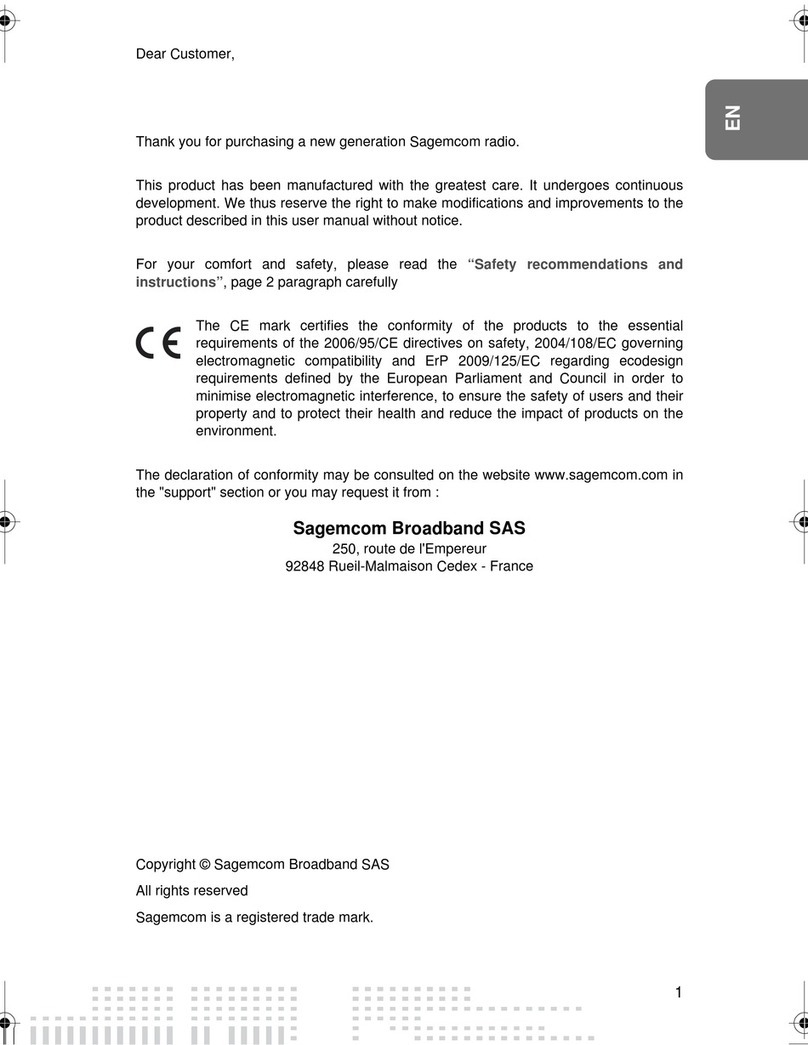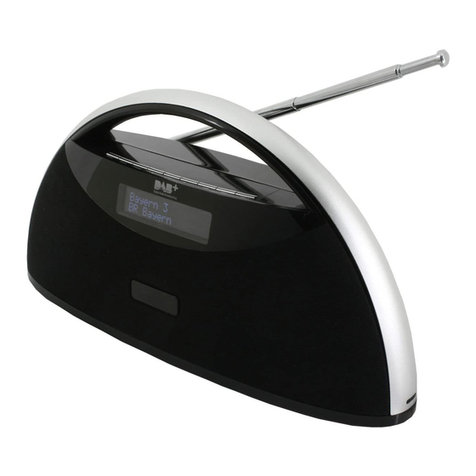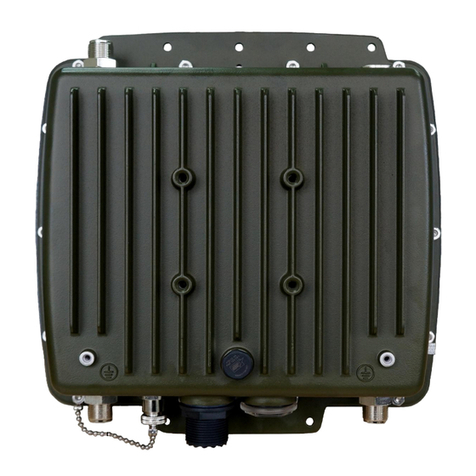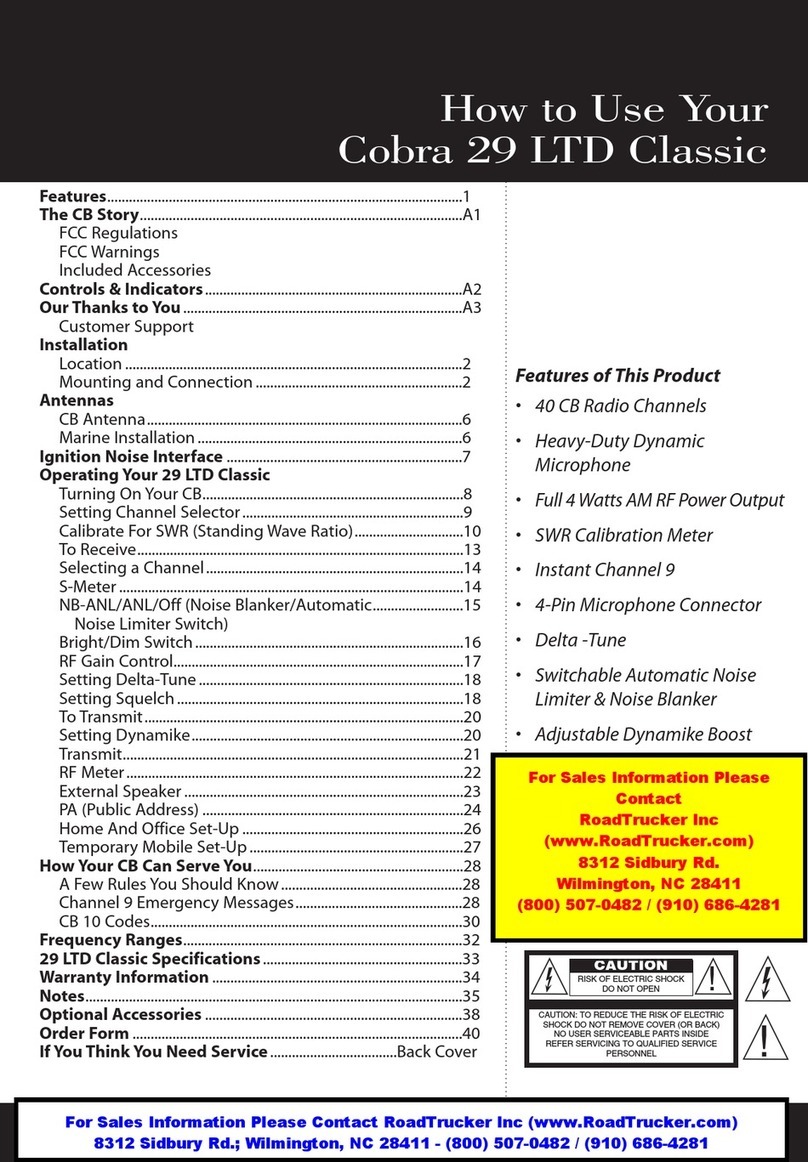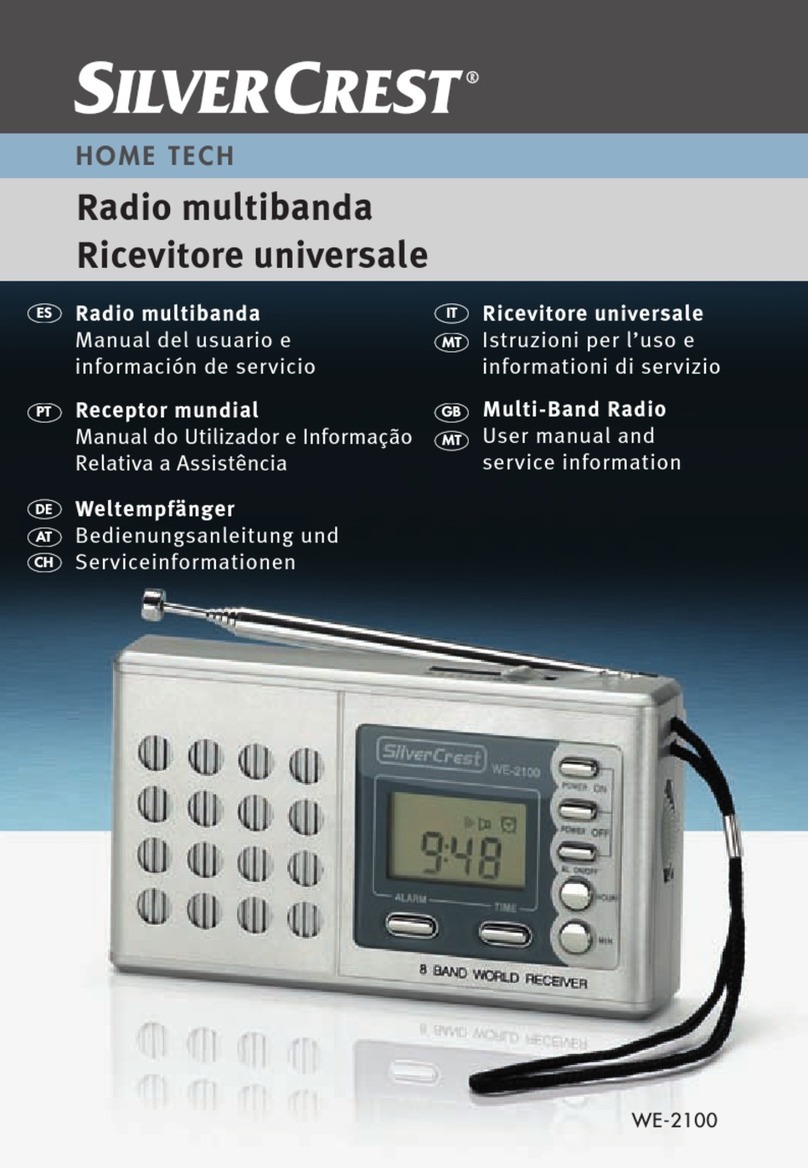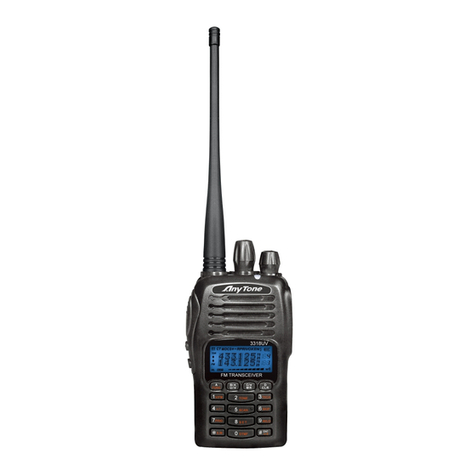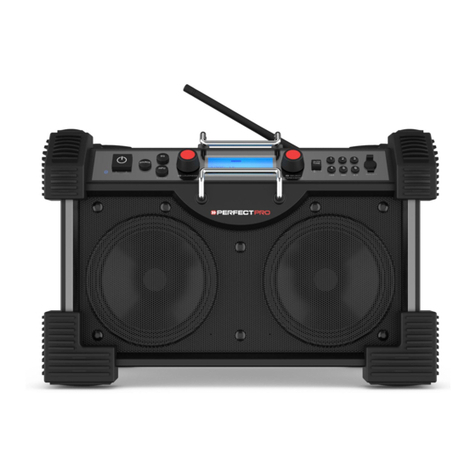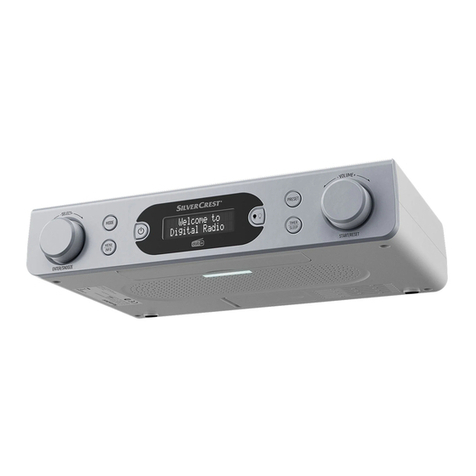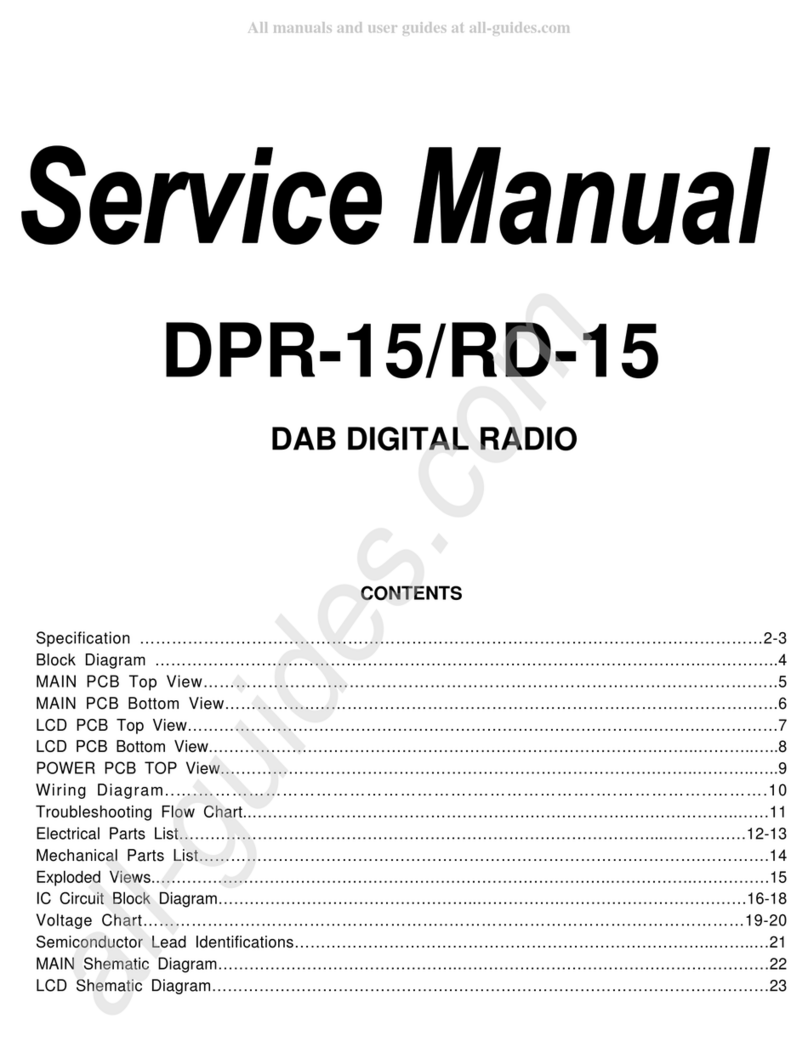ADTRAN TRACER User manual

61280.003L1-1B PAGE I
6/18/98
TRACER USER’SMANUAL

PAGE II 61280.003L1-1B
6/18/98
RADIO FREQUENCY INTERFERENCE STATEMENT
This equipment has been tested and found to comply with the limits for
an intentional radiator, pursuant to Part 15, Subpart C of the FCC Rules.
This equipment generates, uses, and can radiate radio frequency energy.
If not installed and used in accordance with the instructions, it may
cause interference to radio communications.
The limits are designed to provide reasonable protection against such
interference in a residential situation. However, there is no guarantee
that interference will not occur in a particular installation. If this
equipment does cause interference to radio or television reception, which
can be determined by turning the equipment on and off, the user is
encouraged to try to correct the interference by one or more of the
following measures:
• Reorient or relocate the receiving antenna of the affected radio or
television.
• Increase the separation between the equipment and the affected
receiver.
• Connect the equipment and the affected receiver to power outlets
on separate circuits.
• Consult the dealer or an experienced radio/TV technician for help.
W A R N I N G
Changes or modifications not expressly approved by ADTRAN
could void the user’s authority to operate the equipment.
SHIELDED CABLES
A shielded-type power cord is required in order to meet FCC emission
limits and also to prevent interference with nearby radio and television
reception when using the AC voltage adapter. It is essential that only
the Adtran-provided power cord be used.
FCC OUTPUT POWER RESTRICTIONS
The FCC does not require licensing to implement this device. However,
the FCC has established restrictions regarding maximum output power
and the adjustments required when employing directional gain antennae.
(Refer to “Setting the Transmitter Power” in Section 2 of this manual).
These restrictions are detailed in FCC Part 15.247 (b)(1), (b)(3)(i), and
(3)(iii). It is the responsibility of the individuals designing and
implementing the radio system to assure compliance with these and any
other pertinent FCC Rules and Regulations. This device must be
professionally installed.

61280.003L1-1B PAGE III
6/18/98
EXPOSURE TO RADIO FREQUENCY FIELDS
This device is designed to provide a maximum power output of 100 mW.
This level of RF energy in itself is below the Maximum Permissible
Exposure (MPE) levels specified in FCC OET 65:97-01. The installation
of high gain antenna equipment in the system configuration may create
the opportunity for exposure to levels higher than recommended for the
general population at a distance less than one meter from the center of
the antenna. The following precautions must be taken during installation
of this equipment:
• The installed antenna must not be located in a manner that allows
exposure of the general population to the direct beam path of the
antenna at a distance less than one meter. Installation on towers,
masts, or rooftops not accessible to the general population is
recommended; or
• Mount the antenna in a manner that prevents any personnel from
entering the area within one meter from the front of the antenna
• During antenna installation, be sure that power to the Tracer
equipment is turned off in order to prevent any energy presence
on the coaxial connector.
• During installation and alignment of the antenna, do not stand in
front of the antenna assembly.
• During installation and alignment of the antenna, do not handle
or touch the front of the antenna.
These simple precautions must be taken to prevent general population
and installation personnel from exposure to RF energy in excess of
specified MPE levels.

PAGE IV 61280.003L1-1B
6/18/98

61280.003L1-1B PAGE V
6/18/98
CONTENTS
INSTALLATION
PAGE
SECTION 1TRACER DESCRIPTION ..................................................... 1
INTRODUCTION .............................................................. 1
ISM BAND SPREAD SPECTRUM ................................... 1
APPLICATIONS ............................................................... 2
SPREAD SPECTRUM ........................................................ 2
Direct Sequence ........................................................... 3
Coding .......................................................................... 3
CHANNEL SELECTION................................................. 3
FORWARD ERROR CORRECTION .................................... 4
T1 OPERATION ....................................................... 4
Framing ........................................................................ 4
Line Code ..................................................................... 4
DS1/DSX-1 Interface .................................................... 5
Line Buildout or LBO.................................................... 5
TRACER SYSTEM CONFIGURATION .................................. 6
Baseband Processor or BBP........................................ 6
DS1/DSX-1 Interface .................................................... 6
VT-100 RS-232 Interface ............................................. 8
Alarm Contacts ............................................................. 8
IF Signal ....................................................................... 8
AC/DC Power................................................................ 9
Controls and Indicators ............................................... 9
Radio Frequency Convertor or RFC ........................... 11
Antenna ......................................................................13
SECTION 2INSTALLATION ..............................................................15
UNPACK, INSPECT ........................................................15
RACK-MOUNTED RFC CONFIGURATION .........................15
MAST-MOUNTED RFC CONFIGURATION .........................15
INSTALLATION ..............................................................16
LOCATION ............................................................16
POWER REQUIREMENTS ...........................................16
GROUNDING .........................................................16
DS1/DSX-1 INTERFACE ........................................18

PAGE VI 61280.003L1-1B
6/18/98
LINK PLANNING ...........................................................19
ANTENNA FEEDLINE LOSS .........................................20
ANTENNA GAIN ......................................................20
PATH LOSS ..........................................................21
PATH AVAILABILITY .................................................21
SETTING THE TRANSMITTER POWER ...................................22
SETTING THE RFC FREQUENCY PLAN ................................23
CONNECTING THE BBP AND THE RFC ..............................24
APPLYING POWER ........................................................25
SETTING THE BBP FREQUENCY PLAN ................................25
SPREADING CODE ........................................................25
CO-LOCATING MULTIPLE 2.4 GHZSYSTEMS .......................25
ANTENNA ALIGNMENT ....................................................26
RF LOW ...................................................................27
REMOTE BERT ..........................................................27
ALARM CONTACTS ........................................................27
SECTION 3OPERATION ................................................................29
VT-100 USER INTERFACE .............................................29
RS-232 INTERFACE ....................................................29
CABLE CONNECTIONS ....................................................29
PASSWORD ................................................................30
MAIN MENU SELECTIONS ...............................................31
SYSTEM STATUS PAGE .............................................31
MAIN MENU PAGE .................................................32
T1 STATUS PAGE ..................................................32
CHANNEL A STATISTICS PAGE ....................................33
CHANNEL B STATISTICS PAGE ....................................33
ALARM PAGE ........................................................34
TEST MENU .........................................................34
CONFIGURATION MENU ............................................35

61280.003L1-1B PAGE VII
6/18/98
SECTION 4TROUBLESHOOTING .......................................................37
GENERAL ..................................................................37
PROBLEM DESCRIPTIONS AND RECOMMENDED ACTIONS ...........38
TROUBLESHOOTING USING THE FRONT PANEL INDICATORS .....38
“Link Error” light is lit, or link is down...................... 38
“BPV” light on T1-A or B is lit ....................................39
RED light on T1-A or B is lit .......................................39
“LBK-A” or “LBK-B” is lit ............................................ 40
“AIS/YEL” on T1-A or T1-B is lit.................................. 40
“AIS/YEL” indicator is flashing................................... 41
No “Power” light.........................................................41
“Test” light is lit or blinking ....................................... 42
“TST” light is lit after pressing “Remote Test button .42
“Fail” light is lit after pressing “Remote Test” button 43
“RF Low” light is on ...................................................43
TROUBLESHOOTING USING THE VT-100 USER INTERFACE..44
RED Alarm .................................................................. 44
BLV Alarm ................................................................... 44
YEL/AIS Alarm ............................................................ 45
RF Link Alarm or Code Sync Alarm ............................ 46
Carrier Sync Alarm or T1 Mux Framer Alarm ............ 47
ES Values in T1 Status Menu...................................... 48
SES Values in History Menu ....................................... 48
SECTION 5SPECIFICATIONS ...........................................................49
TRANSMITTER .............................................................49
RECEIVER ..................................................................49
FREQUENCY PLANS .......................................................49
SPREAD SPECTRUM DATA PUMP ......................................49
INTERFACE SPECIFICATIONS .............................................50
USER INTERFACE .........................................................50
VT-100 TERMINAL INTERFACE ........................................50
MECHANICAL & ENVIRONMENTAL .......................................50
POWER .....................................................................51
SECTION 6WARRANTY, ORDERING AND RETURN INFORMATION .................53
WARRANTY ................................................................53
SALES ......................................................................53
REPAIRS AND RETURNS .................................................53
TECHNICAL SUPPORT ....................................................54

PAGE VIII 61280.003L1-1B
6/18/98
GLOSSARY .............................................................................55
ACRONYMS USED IN THIS MANUAL ....................................55
APPENDIX ACABLE CONNECTIONS ................................................... A-1
TERMINAL CONNECTION (DB25).................................... A-1
PERSONAL COMPUTER CONNECTION (DB9) ....................... A-1
MODEM CONNECTION (DB25) ...................................... A-2
APPENDIX B FCC REGULATIONS .....................................................B-1
AFFIDAVIT FOR CONNECTION OF CUSTOMER PREMISES
EQUIPMENT TO 1.544 MBPS AND/OR SUBRATE
DIGITAL SERVICES .......................................................B-3

61280.003L1-1B PAGE IX
6/18/98
ILLUSTRATIONS
1-1. Typical Application ......................................... 2
1-2. Bandwidth Division ........................................ 3
1-3. BBP ................................................................ 6
1-4. BBP Rear Panel ............................................. 6
1-5. BBP Block Diagram ....................................... 7
1-6. BBP Front Panel (with door closed) .............. 9
1-7. BBP Front Panel (with door open)................. 9
1-8. RFC Module..................................................11
1-9. RFC Function Block Diagram .......................12
1-10.Mast-Mount RFC Housing .............................13
1-11.Rack-Mount RFC Housing ............................13
2-1. Diplexer .......................................................23
3-1. System Status Page......................................31
3-2. Main Menu Page ..........................................32
3-3. T1 Status Page .............................................32
3-4. Channel A Statistics Page ............................33
3-5. Channel B Statistics Page ............................33
3-6. Alarm Page ..................................................34
3-7. Test Menu.....................................................34
3-8 T1 Loopback Locations ................................35
3-9. Configuration Menu .....................................35

PAGE X61280.003L1-1B
6/18/98

61280.003L1-1B PAGE 1
4/12/99
SECTION 1 TRACER DESCRIPTION
INTRODUCTION
The Tracer provides dual T1 transport by way of a spread spectrum
microwave link for distances up to 20 miles or more depending
on path engineering. System performance is determined, in part,
by the engineering of the microwave link. Each end of a Tracer
link is composed of two units -- the baseband processor (BBP)
and the radio frequency converter (RFC). Two DS1/DSX-1 (T1)
interfaces are provided on the rear of the BBP, which can be
mounted in a 19" rack. The DS1/DSX-1 interface provides
connections up to 6000 feet from T1 equipment. A single coaxial
cable connects the BBP to the RFC and another connects the RFC
to the antenna.
ISM BAND SPREAD SPECTRUM
The Federal Communications Commission (FCC) has established
several portions of the radio frequency (RF) spectrum for use in
Industrial, Scientific, and Medical (ISM) applications. Part 15.247
of the FCC rules describes the requirements of systems that operate
in these bands. The three bands set aside, 902-928 MHz,
2400-2483.5 MHz, and 5725-5850 MHz, are designated for use
by spread spectrum transmitters, either frequency hopping or
direct sequence. The Tracer operates in the 2400 to 2483.5 MHz
band using direct sequence spread spectrum (DSSS) transmission.

PAGE 2 61280.003L1-1B
4/12/99
APPLICATIONS
Any application that would typically use metallic T1 as a transport
can use the Tracer instead. The figure below illustrates a typical
application.
Terminal
VT-100
Switch Cell Radio
RS-232
Cellular/PCSSite
Antenna Antenna
IF Cable
RF Cable
Mast Unit
Mast and Rack mount RFCs may be mixed to accommodate individual system requirements.
TRACER
Baseband Processor
2xT1,Rack-mountedRFC
TRACER
Baseband Processor
T1
T1
T1
T1
MSC
T1A
BPV
DATALOSS
AIS BPV
DATALOSS
AIS
T1B
POWER
TRANSCEIVER
TRACER
2xT1,Mast-mountedRFC
TRACER
T1A
BPV
DATALOSS
AIS BPV
DATALOSS
AIS
T1B
POWER
TRANSCEIVER
TRACER
Rack-mount RFC
RF Cable
Figure 1-1. Typical Application
The Tracer can be used in any application requiring that data be
shared at a high rate of speed. In addition to telephony
applications, Tracer can be used in data communications such as
inter-networking, video conferencing, and telemetry.
SPREAD SPECTRUM
Spread spectrum is a form of communication in which the
bandwidth of a message signal is intentionally increased or
“spread.” The FCC rules allow two methods of spreading --
frequency hopping and direct sequence. Tracer employs direct
sequence spread spectrum.
SECTION 1

61280.003L1-1B PAGE 3
4/12/99
DIRECT SEQUENCE
A direct sequence transmitter spreads the signal by mixing the
data with the output of a pseudorandom number generator which
changes state at a rate higher than the data rate. This rate is called
the “chipping” rate. The Tracer chipping rate is twelve times the
data rate.
CODING
Many different pseudorandom sequences exist. The sequences
are called pseudorandom because, although they appear noise-
like, they are determinant and repeat after a specific number of
chips. The longer a code is, the better correlation characteristics
it possesses. These traits allow multiple spread spectrum systems
to operate in the presence of one another with minimal interference
if they are operating with different sequences. The Tracer allows
the selection of one of ten different 120-bit long sequences.
CHANNEL SELECTION
The FCC has allocated 83.5 MHz of spectrum in the band in which
the Tracer operates. A Tracer system fully uses the available
bandwidth -- transmitting in one half and receiving in the other.
The figure below illustrates the bandwidth division.
2400 MHz 2441 MHz 2483.5 MHz
Figure 1-2. Bandwidth Division
TRACER DESCRIPTION

PAGE 4 61280.003L1-1B
4/12/99
The transmitter at one end (TxA) of a link will transmit in the
lower half of the spectrum. Consequently the receiver at the other
end will receive in the lower half of the band and transmit in the
upper half. Thus, a system will operate in one of two frequency
plans -- transmit in the upper and receive in the lower or vice
versa. These two plans are called Plan A and Plan B. One end of
a path will be on Plan A and the other will be on Plan B. Shipment
of a link will consist of an A and a B unless specified otherwise.
FORWARD ERROR CORRECTION
With the addition of overhead data, error detection and correction
capability can be added to a data stream. Error correction can be
accomplished by allowing the receiver to request the re-
transmission of an errored block once detected. The Tracer, on
the other hand, implements forward error correction (FEC) which
adds enough overhead data for the receiver to detect and correct
errors in the data stream. This capability comes at the cost of
bandwidth. The addition of FEC decreases the required signal-
to-noise (S/N) ratio by approximately 5.5␣ dB to achieve a given
bit error rate (BER).
T1 OPERATION
FRAMING
The data in a T1 stream is delimited by framing bits. The pattern
of the framing bits follows one of two formats -- extended
superframe (ESF) or superframe (SF). The T1 interface must be
prepared for the format that will be used.
LINE CODE
A mark in the data stream is coded as a pulse on the T1 line. A
space is coded as “no activity” on the T1 line. As a form of error
detection, subsequent marks in the data stream are coded as pulses
of alternating polarity, either positive going or negative going. This
type of line coding is called alternate mark inversion (AMI).
SECTION 1

61280.003L1-1B PAGE 5
4/12/99
For the T1 receiver to operate correctly, a minimum number of
“1s” must exist on the T1 facility. If the data cannot be guaranteed
to meet this requirement, then another line coding format is used.
In the bipolar 8 zero substitution (B8ZS) scheme, a string of eight
“0s” is replaced by a special sequence of eight bits that contains a
bipolar violation. The receiver, upon recognizing this sequence,
reinserts the eight “0s” and the data is recovered intact.
DS1/DSX-1 INTERFACE
When connecting the interface to the public switched network,
an ADTRAN-provided cross-over cable (part number
3125.M011@A) is required to meet FCC part 68 and IC CS03
requirements. This cable is required to cross-over the Tx and Rx
pairs to meet the connecting arrangement of a network interface
device. This cable is included with the BBP and is labelled “T1
Crossover.”
LINE BUILDOUT OR LBO
The DS1/DSX-1 interface provides two different types of line
buildouts (LBOs), respectively. When set for DS1, LBOs for 0␣ dB,
-7.5 dB, -15 dB, and -22 dB are available. The DS1 interface can
operate on line lengths up to 6,000 feet. When set for DSX-1
interface, LBOs for 0-133 feet, 266-399 feet, 399-533 feet, and
533-655 feet are available.
TRACER DESCRIPTION

PAGE 6 61280.003L1-1B
4/12/99
Tracer SYSTEM CONFIGURATION
A Tracer system is composed of three major subsystems -- a
baseband processor, a radio frequency convertor, and an antenna.
The following section describes the system components.
BASEBAND PROCESSOR OR BBP
The BBP (ADTRAN part number 1280.003L1) is a 1-U, 19" rack-
mountable unit that provides the system electrical interfaces, user
controls and indicators, and performs the spread spectrum
processing for the system. The rear panel provides all of the
electrical interface points -- DS1/DSX-1 interface, DS1/DSX-1
monitor, VT-100 terminal, alarm contacts, IF signal, DC power
(from facility), and power (from AC adapter). The BBP and its
rear panel are illustrated in the figures below.
TRATRACERCER
Figure 1-3. BBP
Figure 1-4. BBP Rear Panel
DS1/DSX-1 INTERFACE
Two DS1/DSX-1 interfaces, labelled “T1A” and “T1B,” are provided
for connecting to the T1 equipment. Two types of physical
interfaces are provided -- RJ-48C and bantam jacks.
SECTION 1

61280.003L1-1B PAGE 7
4/12/99
The interfaces are illustrated in the BBP Block Diagram below.
The functions of the BBP are partitioned into three printed circuit
boards or PCBs, all contained in the same enclosure.
Σ
T1
T1
T1C
Multiplex
Viterbi
Encoder/
Decoder
Spread
Spectrum
Data
Pump
90
90
Baseband Processor Board
IF Interface Board
Fc = 70 MHz
Fc = 140 MHz
Filter
µCUART DSP
-48Vdc
RS-232
T1A
T1B
IF
Figure 1-5. BBP Block Diagram
The DS1/DSX-1 interfaces provided for each channel are the same.
The upper bantam connectors, labeled “Monitor,” provide isolated
monitor points for testing. The lower bantam jacks provide signal
insertion points. The insertion of a bantam jack disconnects the
RJ-48C connector from the circuit. The DS1/DSX-1 interface can
operate on line lengths up to 6000 feet.
When connecting either T1 interface to the public switched
network, an ADTRAN-provided cross-over cable (part number
3125.M011@A) is required to meet FCC part 68 and IC CS03
requirements. This cable is included with the BBP and is labelled
“T1 Crossover.” This cable is required to cross-over the TX and
RX pairs to meet the connecting arrangement of a network interface
device.
TRACER DESCRIPTION

PAGE 8 61280.003L1-1B
4/12/99
For connections to other CPE-type equipment, such as an
ADTRAN TSU-100, a straight-through T1 cable is provided by
ADTRAN (part number 3127.004) and is included with the BBP.
VT-100 RS-232 INTERFACE
A serial interface port using RS-232C signal levels is provided for
attaching a VT-100-compatible terminal. The connection is made
via a DB-25 connector on the rear panel. The data rate is configured
for 9600 bps, 8 data bits, no parity, and 1 stop bit.
ALARM CONTACTS
Two sets of alarm contacts are provided on the rear of the BBP:
major alarm and minor alarm. A major alarm indicates the radio
link is not operational. A minor alarm indicates that system
performance is degraded or that the T1 interfaces are experiencing
errors. Normally-open and Normally-closed contacts are provided
for both alarm types. Under normal operating conditions there is
no continuity between the Normally-open and Common contacts,
and, under an alarm condition, continuity between those contacts
exists. The Normally-closed and Common contacts normally have
continuity, while under alarm conditions, these contacts are open.
IF SIGNAL
The N-type connector on the rear panel provides the interface
point between the BBP and the RFC. This connection provides
the data signal, power, and configuration information to the RFC.
A coaxial cable (ADTRAN part number 3125.001@A) is provided
for connecting the BBP to the RFC for the rack-mount model .
Cable for connecting the BBP to a mast-mount RFC must be
provided by the customer after the length of cable has been
determined.
SECTION 1

61280.003L1-1B PAGE 9
4/12/99
AC/DC POWER
The unit receives power via one of two connectors. Power for the
entire system is provided by these interfaces. The three-pin circular
DIN connector is provided to connect an optional ADTRAN
desktop AC adapter (ADTRAN part number 1360.DSK24VL1),
providing 24 volts DC. The three-pin terminal block allows the
connection of any DC power source providing between 21 and 56
volts DC. The power consumption of the entire system is 30 watts.
CONTROLS AND INDICATORS
The system may be configured via the front panel, which is
accessible behind a drop-down panel on the right half of the BBP.
The front panel is illustrated in the figure below.
TRACER DESCRIPTION
Figure 1-6. BBP Front Panel (with door closed)
Figure 1-7. BBP Front Panel (with door open)
Options that are set from the front panel can be overridden via
the terminal interface. As a rule, a green LED indicates a good
situation, a red LED indicates an error situation, and a yellow LED
indicates a configuration option. LEDs indicating overall system
integrity are listed below.
Test .............. Red indicates that the self-test has completed and
failed
PWR............. Green indicates that DC voltage is applied

PAGE 10 61280.003L1-1B
4/12/99
The LEDs associated with the DS1/DSX-1 interfaces are listed
below. There are two sections of identical indicators -- one for
each DS1/DSX-1 interface.
BPV .............. Red if the incoming T1 stream contains bipolar
violations
RED ............. Red if there is no signal present at the T1 interface
LPBK ............ Yellow if the T1 interface is in loopback
YEL/AIS ....... Flashes to indicate a T1 Yellow Alarm; remains On
(solid) to indicate an AIS alarm (when the DS1/DSX-1
is receiving a Blue code)
The LEDs indicating error conditions are listed below.
RF Low ................ Red indicates the received RF carrier level is too
low
Link Down........... Radio path is down
The front panel pushbutton controls are listed below.
Reset .................... Reset the system
LBKA ................... Toggles the T1-A between no loopback and line
loopback
LBKB .................... Toggles the T1-B between no loopback and line
loopback
Plan Sel ................ Toggles between frequency plans A and B (must
match frequency plan cabling on RFC). Refer to
“Setting the RFC Frequency Plan” in Section 2 of
this manual.
Remote Test ......... Initiate a remote test across the RF link
SECTION 1
Other manuals for TRACER
1
Table of contents
Other ADTRAN Radio manuals
